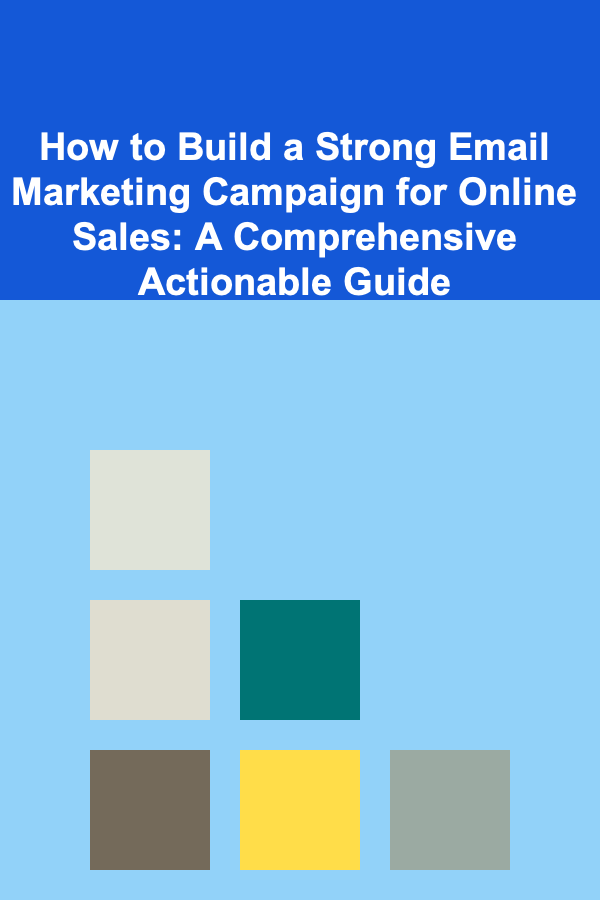
How to Build a Strong Email Marketing Campaign for Online Sales: A Comprehensive Actionable Guide
ebook include PDF & Audio bundle (Micro Guide)
$12.99$10.99
Limited Time Offer! Order within the next:

Email marketing is one of the most powerful tools in the digital marketing arsenal, especially for driving online sales. When done right, email marketing allows you to communicate directly with your audience, build strong relationships, and increase conversions. However, crafting a successful email marketing campaign for online sales requires strategy, creativity, and continuous optimization.
In this comprehensive guide, we'll dive into how you can build a robust email marketing campaign that drives online sales, engages your audience, and delivers measurable results.
1. Define Your Goals and Objectives
The first step in building an effective email marketing campaign is to clearly define your goals. Without clear objectives, your email marketing efforts will lack direction and might not yield the desired results. Common goals for email marketing campaigns aimed at online sales include:
- Increasing Revenue: Your primary goal might be to drive more sales, whether through promoting specific products, flash sales, or seasonal promotions.
- Building Brand Loyalty: Email can be a powerful tool to nurture relationships with your customers, leading to repeat purchases and long-term loyalty.
- Growing Your Subscriber List: Another objective might be to expand your audience base and grow your email list to increase your marketing reach.
- Boosting Engagement: You may also focus on engaging current subscribers by offering personalized recommendations or educational content.
Clearly defined goals will guide your strategy and help you measure the success of your campaigns.
2. Understand Your Target Audience
To ensure your email campaigns are relevant and resonate with your subscribers, you need to understand their needs, preferences, and behaviors. Here's how to gather insights about your audience:
- Analyze Customer Data: Use data from your CRM or email service provider to segment your audience based on demographics (age, gender, location), buying behavior (frequent buyers, one-time purchasers), and other factors.
- Survey Your Audience: Occasionally, send out surveys to your subscribers to gather direct feedback on what kind of products they are interested in and what content they find valuable.
- Track Engagement Metrics: Pay close attention to open rates, click-through rates (CTR), and conversion rates for each email campaign to see which content is most engaging.
By understanding your audience, you can create email content that speaks directly to their interests and needs, increasing the likelihood of conversions.
3. Choose the Right Email List Segmentation
Segmentation is a powerful way to ensure that you are sending the right message to the right audience at the right time. Not all of your subscribers are at the same stage of the buying journey or have the same preferences. Here are a few common segmentation strategies:
- Demographics-Based Segmentation: Segment subscribers based on basic demographic factors like age, gender, or location. For example, you could send location-based offers for events or products relevant to specific regions.
- Behavior-Based Segmentation: Segment subscribers based on their behavior, such as purchase history, website interactions, or email engagement. For instance, send personalized product recommendations to customers who have previously purchased similar items.
- Lifecycle Stage Segmentation: Tailor your messaging to the buyer's lifecycle stage. For instance, send welcome emails to new subscribers, exclusive offers to loyal customers, and re-engagement emails to inactive subscribers.
- Engagement Segmentation: Group subscribers based on their email interaction history. You can send more targeted emails to highly engaged subscribers, while re-engagement campaigns may be needed for less active recipients.
By using segmentation, your emails will be more relevant to each recipient, which can lead to higher open rates, engagement, and conversions.
4. Craft Compelling and Relevant Email Content
Once you have a solid understanding of your goals, audience, and segmentation, it's time to create email content that will drive online sales. Your content should be designed to attract, engage, and convert your subscribers.
Personalization
Personalized emails tend to perform better than generic ones. Utilize the data you've gathered from your subscribers to personalize your messages. Here's how:
- Personalized Subject Lines: Use the recipient's name or location in the subject line to capture their attention.
- Dynamic Content: Show different product recommendations or offers based on their previous purchase history or browsing behavior.
- Special Offers: Tailor promotions and discounts based on a subscriber's buying preferences. For example, offer a special discount on their favorite product category.
Writing Engaging Subject Lines
Your subject line is the first thing recipients see when they receive your email, and it significantly impacts your open rate. A compelling subject line should be:
- Concise: Keep it short and to the point. Aim for around 40-50 characters to ensure it's readable on mobile devices.
- Urgent or Action-Oriented: Create a sense of urgency to encourage immediate action, such as "Last Chance for 30% Off" or "Hurry! Sale Ends Tonight!"
- Curiosity-Driven: Use curiosity to spark interest, e.g., "You Won't Believe What's Inside!" or "A Gift Just for You."
- Personalized: Including the recipient's name or a personalized message can help increase open rates.
Clear and Effective Calls to Action (CTA)
The purpose of your email is to drive action, so your CTA should be clear, direct, and compelling. Whether you want recipients to make a purchase, visit your website, or take advantage of a limited-time offer, your CTA should:
- Be Action-Oriented: Use strong, action-driven words like "Shop Now," "Claim Your Discount," or "Get Your Free Trial."
- Be Visually Standout: Make sure your CTA button stands out in the email design by using contrasting colors and making it large enough for easy clicking.
- Be Located Above the Fold: Ensure your CTA appears early in the email, so recipients don't have to scroll down to take action.
Product Recommendations and Social Proof
Including product recommendations based on previous customer purchases or browsing behavior can increase the chances of a sale. Additionally, showcasing social proof---like customer reviews, testimonials, or ratings---can build trust and credibility, nudging subscribers to make a purchase.
5. Optimize for Mobile Devices
Over half of all emails are opened on mobile devices. If your emails aren't optimized for mobile viewing, you risk losing a significant portion of your audience. Here are a few tips for mobile optimization:
- Responsive Design: Use responsive email templates that automatically adjust to the screen size of the device. This ensures your emails look great whether viewed on a smartphone, tablet, or desktop.
- Shorten Your Content: Mobile users typically prefer shorter, more digestible content. Keep your emails concise and make sure your CTAs are easily clickable.
- Test on Different Devices: Before sending, test how your emails look on various mobile devices to ensure they render properly.
6. Test, Analyze, and Optimize
No email campaign is perfect right out of the gate. Continuous testing and optimization are key to improving the performance of your email marketing efforts. Here's how to optimize your campaigns:
- A/B Testing: Test different elements of your email, such as subject lines, CTAs, images, or copy. A/B testing helps you identify what works best with your audience and can drive higher engagement and conversions.
- Analyze Metrics: Track metrics like open rates, click-through rates, conversion rates, and unsubscribe rates. These key performance indicators (KPIs) will tell you what's working and where you need to improve.
- Iterate and Improve: Use your insights from A/B testing and performance analysis to refine your campaigns over time. Continuously adjust your strategy to optimize for better results.
7. Create Automated Email Campaigns
Email automation allows you to send timely, relevant messages to subscribers based on their behavior or lifecycle stage. Automated email campaigns can significantly increase your online sales and save you time. Here are a few types of automated email campaigns to consider:
- Welcome Emails: Send a personalized welcome email to new subscribers with a special offer to encourage their first purchase.
- Abandoned Cart Emails: Automatically send reminder emails to customers who added items to their cart but didn't complete the purchase. Include a discount or urgency-driven message to nudge them back.
- Post-Purchase Emails: Send follow-up emails after a purchase to thank customers, ask for feedback, or suggest related products.
- Re-engagement Emails: Target inactive subscribers with re-engagement emails, offering exclusive deals or asking them to update their preferences.
Conclusion
Building a successful email marketing campaign for online sales requires careful planning, segmentation, and optimization. By understanding your audience, crafting compelling content, and continuously refining your strategy, you can drive higher engagement and conversions. With the right tools and techniques in place, email marketing can be a highly effective way to boost online sales and build long-term relationships with your customers. Remember, email marketing is not just about pushing sales but also about offering value, building trust, and keeping your audience engaged over time.
Reading More From Our Other Websites
- [Organization Tip 101] How to Track Your Progress and Celebrate Achievements
- [Scrapbooking Tip 101] Seasonal Scrapbooking: Designing Holiday-Themed Vacation Keepsakes
- [Personal Investment 101] How to Sell Your Deep Learning Models for Passive Income
- [Home Holiday Decoration 101] How to Create a Cozy Scandinavian Holiday Home
- [Home Storage Solution 101] How to Find Stylish Shoe Storage Ideas for Every Entryway
- [Organization Tip 101] How to Use Mindful Breathing Techniques During the Day
- [Soap Making Tip 101] Best All‑Natural Exfoliating Soap Recipes with Coffee and Walnut Shells
- [Mindful Eating Tip 101] Integrating Mindful Breathing into Meals: Simple Techniques for Daily Practice
- [Home Pet Care 101] How to Prevent a Dog from Chewing Shoes: Behavior Training and Solutions
- [Home Rental Property 101] How to Turn Your Rental Property into a Profitable Business

Becoming a Successful Game Developer: Essential Skills for Building Immersive Worlds
Read More
How to Organize Your Movie Collection for Easy Viewing
Read More
How to Use Vintage Boxes for Stylish Storage
Read More
How to Create a Fitness To-Do List for Busy Moms
Read More
10 Tips for Managing Client Expectations in Consulting
Read More10 Tips for Maximizing Your Fertility Tracker Planner
Read MoreOther Products

Becoming a Successful Game Developer: Essential Skills for Building Immersive Worlds
Read More
How to Organize Your Movie Collection for Easy Viewing
Read More
How to Use Vintage Boxes for Stylish Storage
Read More
How to Create a Fitness To-Do List for Busy Moms
Read More